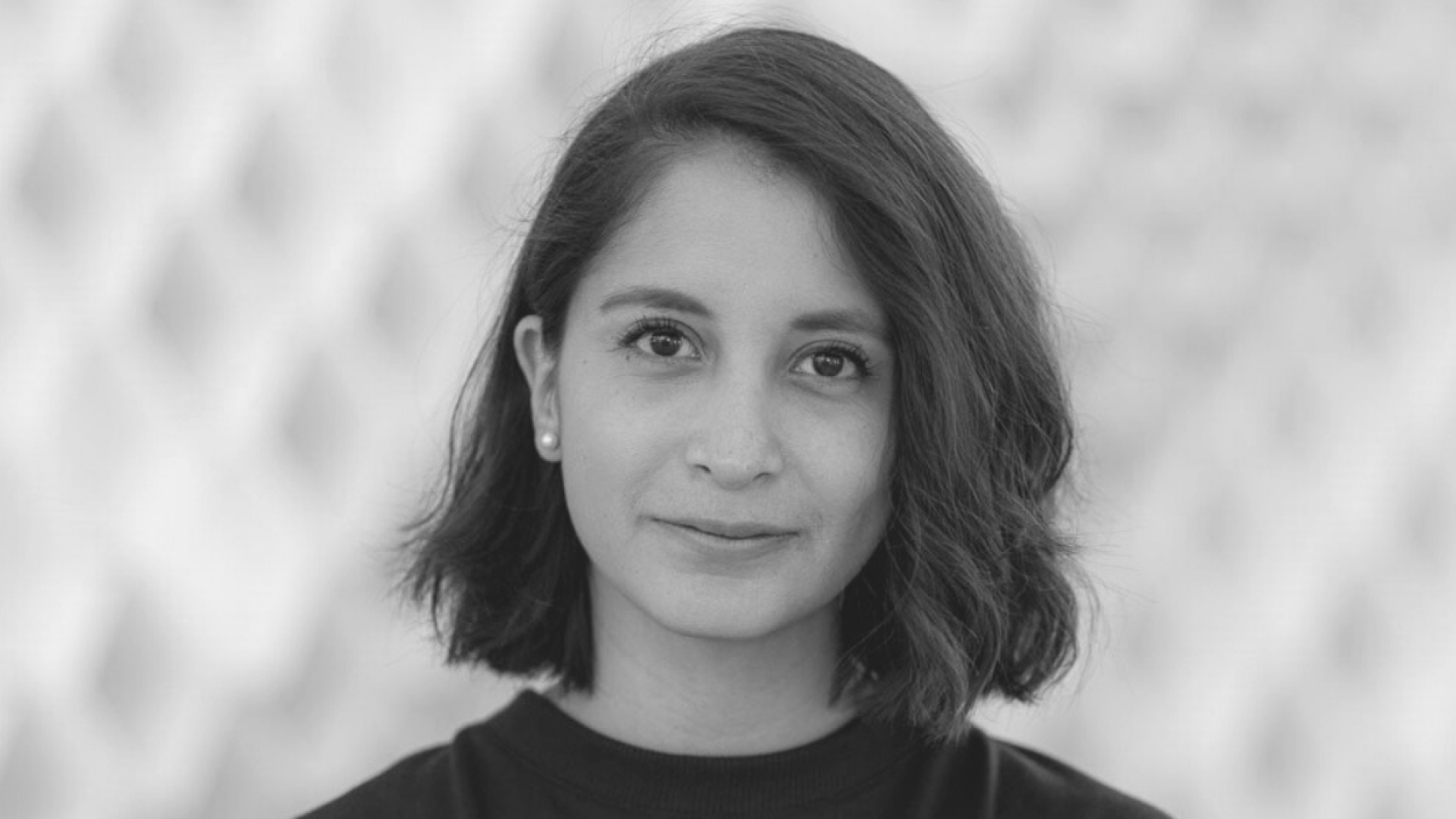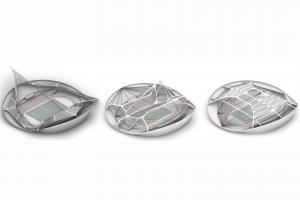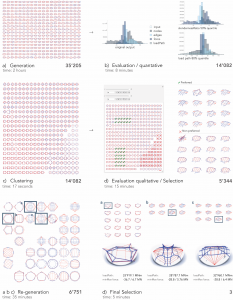
Image © Karla Saldaña Ochoa
Going Beyond Typologies and Optimization: A Conversation with Karla Saldaña
Drawings have been the traditional medium architects use to organise ideas and explore design options. When designing, we intuitively think about associations and interrelations between different design constraints and possible design solutions. Translating this cognitive process onto paper poses many limitations. When translating design intent to paper, it’s hard for designers to manage these associative relationships, and it is up to them to ensure the design’s internal consistency. This limitation spurred the need to have a set of standards in the form of predefined design solutions and tectonic systems, known as typologies.
Typologies allow the designer to use drawings to explore and iterate over the design solution space within a set of structural and formal constraints, making it easier to manage associative relationships. Architects and engineers have long relied on typologies in the form-finding process. Still, given the structural and formal constraints typologies introduce, it becomes hard to innovate and limits the possible design options to a small solution space. Various approaches have been explored in the past that try to bypass the use of typologies. For example, in the 19th-century, architects such as Antoni Gaudí started to explore physical form-finding methods, where physical forces could drive the final form. These approaches have remained a niche within the industry.
Even as digital tools became widely available, they did not directly translate into new modes of design thinking. CAD (computer-aided design) was initially translations of traditional drawings’ additive logic to a digital environment. It hasn’t been until more recently that software and tools that allow for, and help manage, associative relationships have proliferated. This adoption was fueled by both an increase in computational resources and new approaches to design, such as those implemented in the early 20th century by the Italian architect and structural engineer Sergio Musmeci embracing the role of science as a creative tool. Today, Building Information Modeling (BIM) and tools such as dynamo and grasshopper make it possible for designers to take a more computation approach, defining processes and relationships that guide the design process rather than a final output. These new design methods became known as parametric design. Architectural firms such as Zaha Hadid Architects have pushed the boundary of what is possible with these new approaches and tools.
However, parametric design has created its own set of limitations. Optimisation routines, which are often used in parametric design, work well when solving specific sub-problems such as sizing structural elements or optimising typologies but fall short in more complex applications. Additionally, the space of possible design solutions generated by these tools and algorithms quickly becomes too big for anyone to explore in any meaningful way. To tackle this, researchers from the Department of Architecture of ETH Zürich have recently proposed a new framework for generating design options that are novel, diverse, and structurally informed.
The proposed framework, published in the International Journal of Architectural Computing, goes beyond typologies and optimisation routines by taking advantage of recent advances in machine learning and leveraging these with feedback from designers, an approach known as “human in the loop” machine learning. The framework is loosely based on a generic scheme of design operations formalised by Israeli architect Rivka Oxman. It consists of 4 procedures outlined in their paper: generation, clustering, evaluation, election, and regeneration. Researchers propose three main algorithms related to these operations: combinatorial equilibrium modeling is used in the generation stage (similar to Geometric Equilibrium through 3D Graphical Statics approach), self-organising maps to clusters the outputs, and gradient-boosted trees to learn user preferences and incorporate subjective criteria during the election stage. The framework is flexible, and these specific algorithms could be replaced by different ones depending on specific needs. Data Aided Design had the chance to speak to Karla Saldaña Ochoa, the paper’s principal author, to discuss the work in more detail.

What initially sparked the interest in the research?
What sparked our interest was the intention to combine human cognition with machine-driven computation, joining humans’ subjective evaluation and selection capacity with machines’ ability to handle large datasets. Our groups (Chair of Digital Architectonics and the Chair of Structural Design) are part of the Institute of Technology in Architecture at ETH Zurich, where we often meet and spontaneously talk about current ideas and projects. This friendly environment made it possible to meet, discuss, and collaborate. Such collaboration resulted in a structural design framework that allows generating multiple novels, diversified, and structurally informed design options that could be handled masterfully by joining algorithms of Machine Learning and human decision-making to select one design option fulfilling all the designer’s qualitative and quantitative criteria.
In the research, you talk about how typological references are a big part of the design process within engineering, and the need to move towards non-typological approaches. Do you think this is also the case in other design fields, and from your point of view, what are the biggest challenges in these new approaches being adopted by different design communities?
For us, the idea of having a non-typological approach towards design is an important requirement, especially at the early conceptual design phases. Because it is there where the designer is exploring conceptually possible solutions that could result in design options with similar formal representations if predefined by typological constraints. The design framework that we propose, thanks to its flexibility, is intended to be implemented in different design scenarios. The four sequences of operations described in the paper are intended to be variable and user-dependent. Hence, depending on the designer’s question, the order and the relevance of the operations can be adjusted to fulfil the design brief. In the context of computer-aided modelling, we see a trend towards parametric design to address the last question. On the one hand, this approach can open up exploration within a typologically explicit defined design space but eventually will limit critical topological explorations. Hence, design exercises that rely solely on parametrization will encounter a significant challenge to adopt an approach that goes beyond typologies.
What sparked our interest was the intention to combine human cognition with machine-driven computation, joining humans’ subjective evaluation and selection capacity with machines’ ability to handle large datasets.
In its broadest sense, one of the questions you are trying to answer is how to leverage both human and machine intelligence in the design process. Do you see the potential for the framework in facilitating collaboration between different disciplines and contrasting objectives?
Throughout time humans have created instruments that augmented their capacities. It started with the Greek Empire, with the ruler and the compass, the Renaissance period with the printing, and the Industrial Revolution with the mass-production of anything. Each technological invention has paved the way for creating today’s technology, “Machine Intelligence” (MI). Currently, MI is built by a twofold approach: one that seeks to reduce human intelligence into symbolic manipulation and another one that tries to mimic the models of neural behavior and create a mathematical model for it. One of the commonly used and researched types of MI is the Artificial Neural Nets, which mainly perform pattern recognition on input data. I argue that this kind of MI cannot be considered intelligence, understanding intelligence as discovering and inventing new rules. Hence, I think that MI is here to augment human capability, not replace its position entirely. With that said, I can tackle your question about a design-process with a collaboration between human and machine intelligence. I believe that design is an activity with much or all to do with creating novelty based on designer preferences and training. The idea of using MI in the design process is to utilize its computational power to explore the space of possibilities defined by the human designer. MI can guide/support the selection of possible design options based on the similar patterns arising from the plenty of options. This is further explained in the paper section, which addresses the Qualitative Evaluation and Selection. There we wrote, “This approach enables going beyond solely objective functions by considering those subjective formal qualities perceived by the human designer. Once the solution space is generated, evaluated, and clustered, the human designer can select those clusters or single design options that have the overall best performance concerning quantitative (measurable) and qualitative (non-measurable) aspects.” In our work, we emphasize that the human designer is entirely in charge of the process and uses machine intelligence to ease his/her exploration journey. Because when working with Machine driven generative tools, the designers encounter the dichotomy between the desired diversity of the design space on the one end and the difficulty for humans to interact with a large amount of data on the other hand. Therefore, we propose a design framework that utilizes MI to augment the designer’s capacity to navigate and select preferred design options to continue with the design exploration that will yield a final product. To address the question of the potential of facilitating collaboration between different disciplines and contrasting objectives. I start by asserting that this question was one of the original motivations for this collaboration. The project is intended as a demonstrator of a collaboration between a structural designer and an architect. The tools we propose can become a common language among different disciplines. Moreover, it was designed to be as flexible as possible, to add as many quantitative and qualitative constraints as many fields involved. To conclude, for us, Nicolas Negroponte’s quote resumes our opinion: “The best way to appreciate the merits and consequences of being digital is to reflect on the difference between bits and atoms.” One could thus argue that machines and humans have fundamental differences in their internal structure. Indeed, bits can very likely not replace atoms, but they can be used to empower them.
© Karla Saldaña Ochoa





